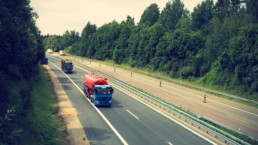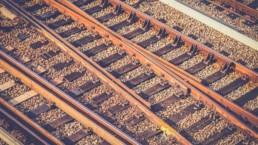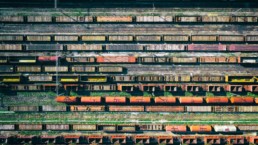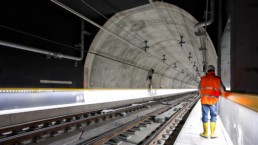HOW TO PUT MORE FREIGHT ON RAIL
If you were to move 1,000 tonnes of freight from Rotterdam to Vienna, you would emit 100 tonnes of CO2 less by train than by truck. This is the reason why rail is supported through climate change policy and by many environmental NGOs. Yet, the complexities of the freight industry have made it hard for trains to transport goods. As a result, trucks carry over 75% of freight in Europe and account for a quarter of the greenhouse gas emissions from road transport. Rail’s performance needs to improve if it is to play an optimal role in reducing the impact of transport on climate change.
Transport & Environment has been researching the rail freight sector over the past three years; organising workshops with key stakeholders and visiting hubs and headquarters. The aim of this research is to better understand what needs to change in order for more freight to be transported by train.
This website provides the lessons learned during the course of the project, as well as policy recommendations to improve the existing state of the railway sector in Europe. The information gathered from stakeholders feeds into a research project that is lead by Fraunhofer ISI. Links to that research project will also be provided on this website.
We’ll release 7 lessons in total, one per month. If you wish to receive them directly in your email box, register here:
SETTING THE SCENE
“For the Commission, rail is a key sector: You are the centre piece of our decarbonisation strategy. We want to see more people travelling by train and more companies choosing to move their goods by rail. I have faith in the sector, I fully support you: but I am relying on you to keep your side of the bargain” – Violeta Bulc, Commissioner of Transport, addressing the industry at the Innotrans Conference, September 2016.
The European Union has long promoted rail as a means to reduce the impact of transport on climate change. The EU has invested a lot of time and money into their goal of shifting more freight from trucks onto trains (a goal often referred to as “modal shift”). It’s important to know what’s been done in order to better understand what is still needed.
LESSONS
POLICY RECOMMENDATIONS
T&E has developed policy recommendations based on the findings of our research on rail freight. Rail freight has growth potential. But many changes must be made, to both the business practices of the industry and the policy that’s in place to support rail.
There is a disparity between how different transport modes are charged for their use of infrastructure in Europe. Rail pays for every kilometre of infrastructure use while a far smaller percentage of the road network is subject to tolls for trucks. EU member states should toll trucks across the entire road network if they want rail to be more competitive with road. The benefits of such tolls go beyond modal shift as they can improve the overall efficiency of freight logistics while encouraging truck drivers to buy the most environmentally friendly vehicles on the market.
Pricing is only one reason why road dominates the freight market.
Rail has a data problem. Companies active in rail collect an insufficient amount of data and the data they do collect is kept under lock and key in their headquarters. Intel about infrastructure use could play a role in improving the efficiency of services and identifying areas in need of investment.
It would also improve the objective understanding of diesel and electric locomotive usage in Europe. At the moment the only available data regarding such use is industry figures.
Finally, open data can improve the awareness of railway infrastructure within the logistics sector. If data were shared then logistic companies or shippers could provide maps to potential clients of areas where they have operations that are close to railway sidings of rail freight terminals. These maps would also be beneficial for train operators as they could potentially attract new clients.
The EU should oblige a level of data sharing in the rail industry. Infrastructure is built with public investments so data relating to the operation and location of such infrastructure should be collected and made publically available. Although it may seem like there is a rather niche demand for such data, it will be important if rail is to play an optimal role in the digitalisation of logistics.
The EU has invested billions of euro into building railways. More than €33 billion of the 2014-2020 EU budget will be invested into rail (an increase from €28 billion between 2007-2013). This is just a fraction of what Europe as a whole invests in trains. Rail infrastructure spending has increased from €29 billion in 2011 to €45 billion in 2014 (a 55% increase in three years). Over 50% of this €45 billion goes towards maintaining and renewing existing infrastructure. About 45% (over €20.4 billion) goes into building new railway lines.
EU investment often goes towards new infrastructure projects that have a clear “EU dimension” due to their scale. But money should rather be spent on updating existing infrastructure and improving the ability for trains to cross borders seamlessly by removing the bottlenecks and such low-hanging fruit. New infrastructure should only be built if there’s clear evidence that demand is there to warrant the investment. The EU will draft the post-2020 budget between now and late 2019. Rail should continue to receive co-financing but such safeguards should be established to ensure that spending is having an impact on advancing the EU’s vision for rail.
Shift2Rail is a public private partnership whereby industry financing is combined with EU funds to develop research and innovation on rail technologies. The EU’s contribution amounts to €450 million. Only 30% of the research projects are open to proposals from non-industry actors. This limits the research that can be performed by academia, civil society, startups, and independent engineers. The railway industry plays a central role in determining what needs to be developed and what research calls should be open beyond the industry circle.
There is no problem in the fact that industry helps to define areas in need of further research as they are best positioned to know about the day-to-day challenges the sector is facing. The issue is that research becomes limited to innovation that the industry foresees and welcomes. This negates any potential disruptive innovation coming from projects like Shift2Rail. The EU should open a consultation whereby non-industry stakeholders in rail can contribute ideas on what the Shift2Rail research and innovation should be focusing on. This would better ensure that the EU contribution is well spent.
The rail freight market in Europe has been liberalised since 2007. The high capital costs involved in rail make it an expensive market to enter. This has resulted in competition not radically changing rail freight the way that it did to the road haulage market where thousands of companies compete with one another. Nevertheless, new entrants hold about 26% of the rail freight market today. This is largely new investors in rail freight but also includes national champions who decided to open subsidiaries abroad. Rail’s share of the freight market has not improved much since market liberalisation.
More still needs to be done if competition is to be pursued in the European rail freight market. Incumbent operators must learn to share some of the privileges that they inherited from having been state owned. Access should be granted to workshops and other service facilities, whereby new entrants can avail of such facilities for a fair price. There also must be some obligation on rail operators to sell the rolling stock (i.e. locomotives and wagons) that they do not use to new entrants. It is inefficient to have such expensive machines sitting idly on the tracks.
Rail regulators must be given a boost in terms of resources in order to properly ensure that infrastructure is being fairly used. Anticompetitive practices that restrict the growth of rail freight serve no company’s purpose and should be penalised. The national regulators must also be making sure that foreign trains are not being treated any different to national trains.
In addition to competition, rail must collaborate. These seemingly opposed requirements are telling of how unique the railway market is. Infrastructure managers need to collaborate across borders in order for international rail to become more seamless. The Rail Freight Corridors are an important EU initiative in this respect and should continue to be supported by EU member states. Data needs to be made available to better assess the performance of corridors.
EU member states also need to collaborate more with the European Union Agency for Railways in order to establish interoperability across the various national systems and harmonise technical standards. If international rail is to grow in Europe then the Agency’s objectives need to be continuously supported so that a single European railway area can be established.
On top of that, national regulators must be collaborating to ensure fair competition in the market. An understanding of the anticompetitive practices across Europe can help the various regulators look out for similar practices within their home market. This collaboration could be supported and overseen by the European Union Agency for Railways.
These proposed changes will help to improve Europe’s rail freight market and shift more freight onto rail. But rail alone will not get us to a zero emission freight transport system. Road will always transport the vast majority of freight. Rail should be supported to boost modal shift but, more widely, Europe needs to develop a plan on how we can get to zero emission inland freight. Rail is only one part of this puzzle.







